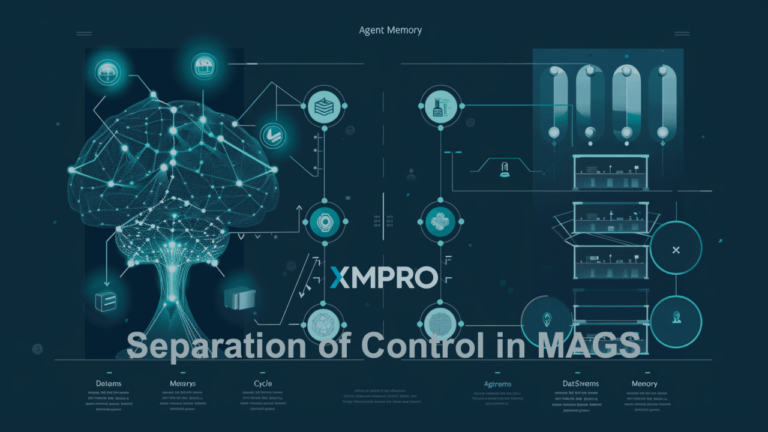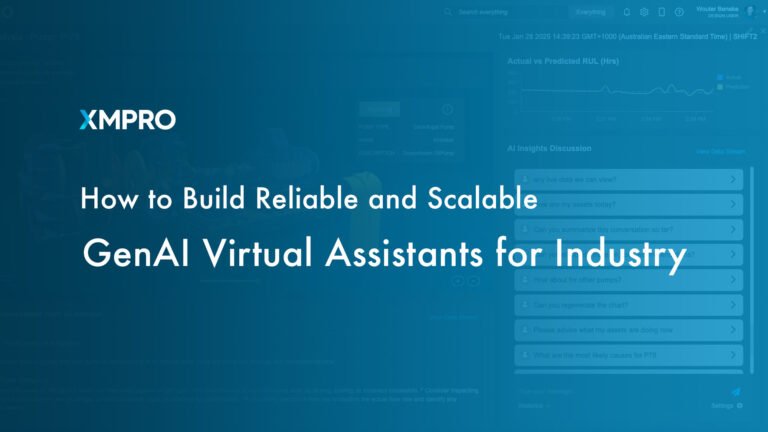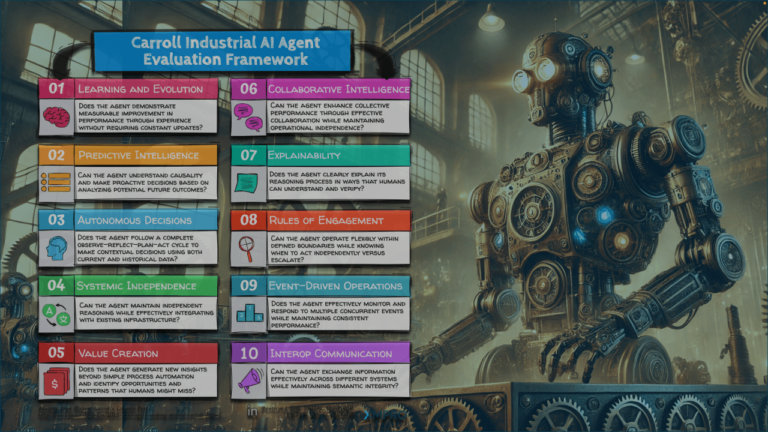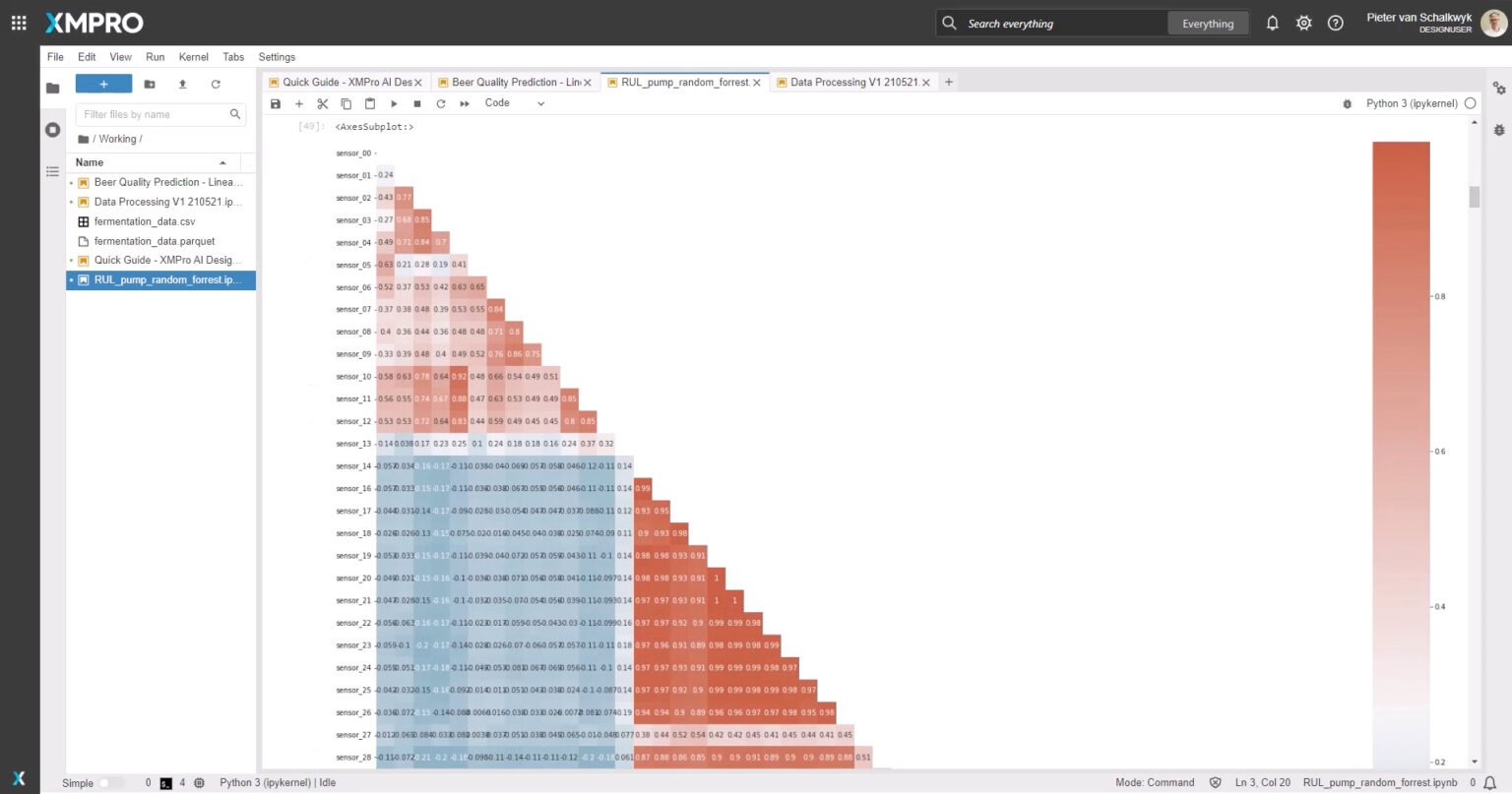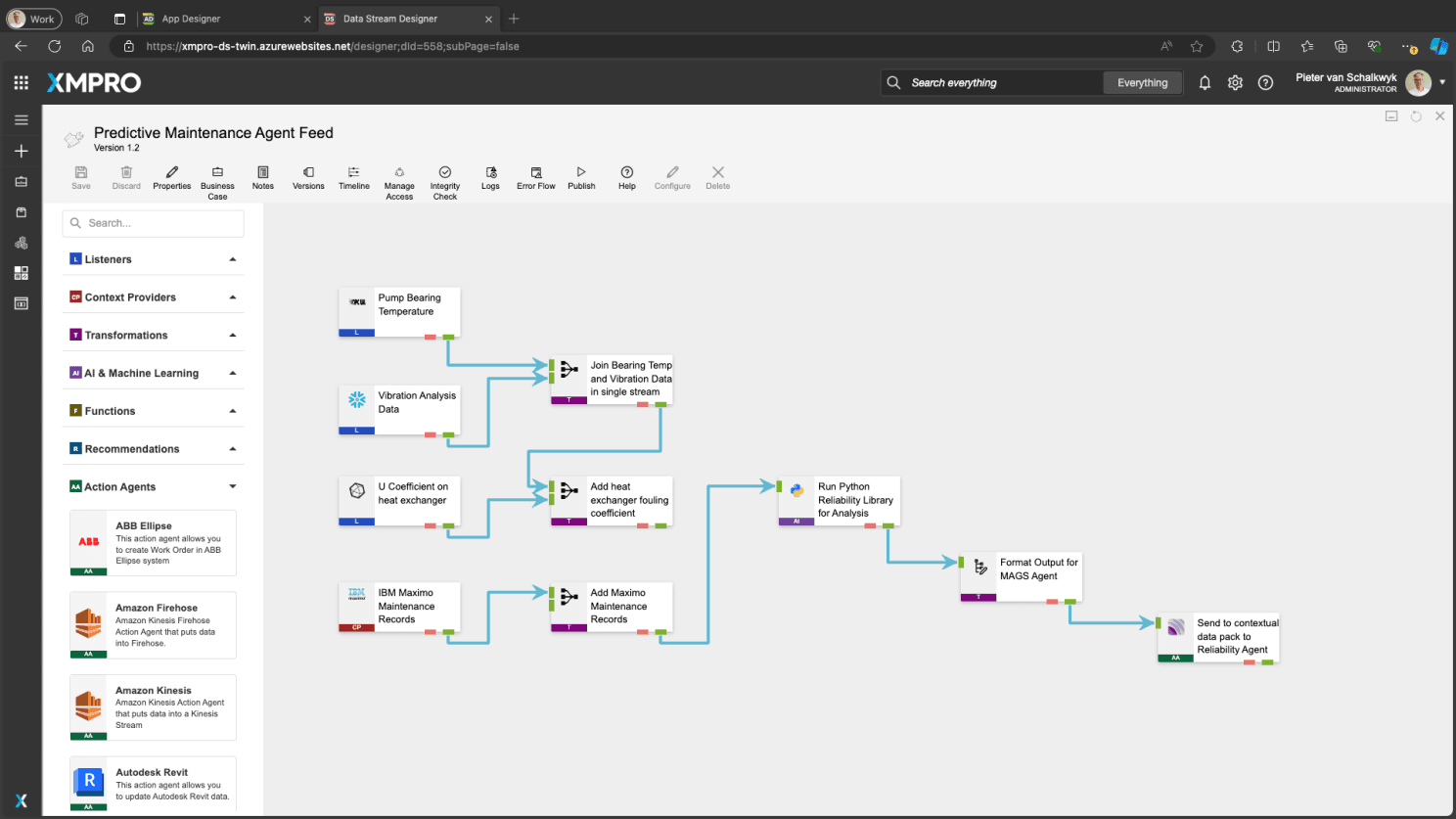The Ultimate Guide To Predictive Analytics
1. Introduction to Predictive Analytics
Overview
Predictive analytics uses historical data, statistical algorithms, and machine learning to predict future outcomes. Predictive analytics techniques are essential for enhancing decision-making and operational efficiency in various industries. Predictive analytics is becoming increasingly important in industrial operations to enhance decision-making and efficiency, offering predictive analytics benefits that drive competitive advantage. A recent survey found that 76% of asset-intensive companies have adopted predictive analytics to improve operational efficiency and asset management. This shift is largely driven by the need to minimize downtime, optimize resource use, and gain a competitive edge.
XMPro’s Perspective
XMPro’s predictive analytics platform is tailored to address the unique challenges of asset-intensive industries. By integrating data from sensors, historical logs, and operational systems, XMPro enables organizations to predict issues before they become critical. For example, in mining operations, XMPro’s predictive models, using data from sensors, operational logs, and historical analysis, helped a client reduce unplanned downtime by 25%, leading to significant cost savings and higher productivity. By leveraging sensor data for real-time monitoring and historical data for trend analysis, XMPro was able to provide proactive insights that led to timely maintenance interventions. This tailored approach ensures both operational and strategic decision-making are data-driven.
Why Predictive Analytics with XMPro?
XMPro’s Intelligent Business Operations Suite (iBOS) offers streamlined implementation of predictive analytics, designed to turn data into actionable insights quickly. The platform’s flexibility allows users to deploy predictive models seamlessly into their existing processes, providing real-time insights for proactive decision-making. This means fewer disruptions, better resource allocation, and improved overall performance.
2. The Predictive Analytics Process with XMPro
Data Collection and Preparation
XMPro simplifies the process of collecting and preparing data by integrating multiple data sources, including IoT devices, historical databases, and third-party data streams. High-quality data is essential for predictive analytics accuracy, and XMPro’s platform helps ensure data consistency and reliability through automated data cleaning, data quality checks, and validation. This step reduces errors and ensures that predictive models are built on solid foundations.
Exploratory Data Analysis (EDA)
Exploratory Data Analysis (EDA) is a critical part of the predictive analytics process. XMPro’s visualization tools help users explore data relationships, identify trends, and uncover key variables that influence outcomes. By providing intuitive dashboards and interactive graphs, XMPro allows analysts to quickly understand their data, setting the stage for effective modeling and insight generation.
Model Selection
XMPro offers a variety of built-in models and the flexibility to integrate advanced machine learning libraries such as TensorFlow and Azure ML. This approach allows users to select the most appropriate predictive model based on the specific use case. XMPro guides users through the predictive analytics model selection process, helping them choose between techniques like regression, classification, and clustering, depending on their goals and the nature of their data.
Model Training and Validation
Training and validating predictive models are essential to ensuring their accuracy and reliability. XMPro provides tools for splitting data into training and testing sets, which helps in evaluating model performance effectively. By continuously monitoring model outputs and recalibrating as needed through feedback loops and automated monitoring tools, XMPro helps organizations maintain the accuracy of their predictions over time, even as conditions evolve.
Model Deployment with XMPro
XMPro enables seamless real-time predictive analytics deployment, allowing predictive insights to be delivered directly where they are needed. Integration with existing operational workflows ensures that predictive models are not just theoretical exercises but become practical tools for decision-making. For instance, predictive maintenance alerts can be sent directly to maintenance teams, enabling swift action that prevents costly breakdowns.
3. XMPro’s Key Techniques for Predictive Analytics
Statistical Modeling and Machine Learning
XMPro supports a range of statistical and machine learning techniques, such as Random Forest and Support Vector Machines, to address diverse predictive analytics needs. Users can apply foundational methods like linear regression for trend analysis or use advanced algorithms such as decision trees and neural networks for more complex predictions. By offering a variety of approaches, XMPro ensures that organizations can tailor predictive models to meet their specific challenges, from simple trend forecasting to detailed anomaly detection.
Agentic AI with XMPro
XMPro incorporates Agentic AI through its Multi-Agent Generative Systems (MAGS) and APEX AI, allowing systems to react dynamically to changing conditions. These AI-driven agents can autonomously gather data, analyze it, and initiate actions in real time. For example, when equipment in a manufacturing plant begins showing early signs of wear, MAGS can initiate a series of actions—from alerting maintenance teams to adjusting operational parameters—to mitigate potential issues. This proactive, adaptive response capability makes XMPro’s predictive analytics uniquely effective in fast-paced industrial settings.
Condition Monitoring and Predictive Maintenance
XMPro’s platform excels in condition monitoring and predictive maintenance, providing real-time insights into asset health. For example, in the mining industry, XMPro has been used to monitor the condition of conveyor systems, identifying early signs of wear and potential failures. This has allowed operators to schedule maintenance proactively, resulting in reduced unplanned downtime and increased operational efficiency. By continuously analyzing data from sensors and other sources, XMPro can detect anomalies early, preventing costly equipment failures. Predictive maintenance powered by XMPro helps organizations optimize maintenance schedules, reduce unplanned downtime, and extend the life of critical assets, highlighting predictive analytics benefits for maintenance. The platform’s ability to deliver timely, actionable insights helps organizations maintain high levels of operational efficiency and reliability.
4. Data Sources and Integration with XMPro
Unified Data Ingestion
XMPro offers seamless data integration for predictive analytics with diverse data sources, ensuring that organizations can consolidate their data into a unified platform. Data can be ingested from a variety of sources, including IoT sensors, SCADA systems, historical databases, and third-party APIs. This comprehensive data integration is crucial for developing accurate predictive models, as it provides a holistic view of operations. By unifying data from multiple sources, XMPro enables real-time insights that lead to more effective decision-making.
Industrial IoT Compatibility
XMPro’s compatibility with Industrial Internet of Things (IIoT) devices allows for real-time data collection and analysis at scale. XMPro can process vast amounts of sensor data from connected assets, enabling predictive analytics that can identify potential issues before they escalate. For example, by integrating data from temperature sensors, pressure gauges, and vibration monitors, XMPro can provide insights that help optimize equipment performance and prevent failures. This compatibility makes XMPro a powerful tool for industries such as oil & gas, mining, and manufacturing, where real-time monitoring is essential for maintaining productivity and safety.
Contextual Data Integration
In addition to sensor and operational data, XMPro also integrates contextual data—such as weather information, market conditions, and maintenance logs—that can enhance the predictive analytics process. By incorporating these additional data streams, XMPro allows organizations to consider a broader set of factors when analyzing potential outcomes. This enriched context improves the accuracy of predictions and helps organizations anticipate the impact of external variables on their operations, ultimately leading to more robust and informed decision-making.
5. Predictive Analytics Use Cases with XMPro
Manufacturing
In manufacturing, XMPro’s predictive analytics capabilities are used to reduce downtime, improve quality control, and optimize production processes. Predictive maintenance helps identify equipment issues before they result in costly breakdowns, ensuring that machinery is maintained efficiently. For instance, a manufacturer using XMPro saw a 30% reduction in unplanned downtime by implementing predictive analytics to monitor machine health. This led to increased operational efficiency and lower maintenance costs.
Utilities and Energy
For utilities and energy companies, predictive analytics enables real-time grid monitoring, demand forecasting, and proactive asset management. XMPro integrates data from various sources, such as smart meters and grid sensors, to predict demand fluctuations and optimize energy distribution. By forecasting equipment failures, utilities can reduce downtime and improve reliability. A utility company using XMPro was able to cut maintenance costs by 20% through better asset management and predictive insights.
Agriculture
In agriculture, XMPro helps optimize crop yield, monitor soil health, and improve farm management practices. Predictive analytics allows farmers to make informed decisions regarding irrigation, fertilization, and pest control based on real-time data and weather forecasts. For example, XMPro’s predictive analytics enabled a vineyard to optimize its irrigation schedule based on soil moisture data and upcoming weather conditions, resulting in a 20% reduction in water usage while maintaining crop quality. By integrating sensor data and contextual information, XMPro provides insights that help farmers boost productivity and minimize resource usage. For example, XMPro’s analytics enabled a farm to increase yield by 15% through optimized irrigation strategies.
Mining
In mining, XMPro’s predictive analytics are used to enhance operational efficiency, safety, and resource management. Predictive maintenance is crucial for reducing equipment failures, such as those involving crushers, conveyors, and haul trucks. By monitoring operational data in real-time, XMPro helps identify early warning signs of equipment issues, allowing for timely interventions that prevent costly breakdowns. In a mining operation, XMPro helped optimize crusher maintenance schedules, reducing unplanned downtime and improving throughput rates. Predictive analytics also aid in optimizing blasting and drilling schedules to maximize resource extraction while minimizing environmental impact.
Oil & Gas
In the oil & gas industry, XMPro provides predictive insights that support safe and efficient operations, including the monitoring of drilling rigs, pipelines, and refining processes. Predictive analytics help identify anomalies in pipeline pressure and flow, preventing leaks and ensuring environmental safety. XMPro’s predictive maintenance capabilities also help oil & gas companies maintain the integrity of offshore and onshore equipment, leading to reduced risk of operational disruptions. One oil & gas client using XMPro achieved a 25% reduction in unexpected maintenance incidents by leveraging predictive analytics for proactive equipment monitoring.
Renewables
In the renewables sector, XMPro’s predictive analytics are used to optimize the performance of wind turbines, solar panels, and battery storage systems. By integrating weather data with real-time performance metrics, XMPro helps renewable energy companies predict power generation and proactively manage assets. Predictive analytics also assist in optimizing maintenance schedules for wind turbines, reducing downtime and extending the lifespan of components. For instance, a renewable energy company using XMPro saw a 15% increase in energy production efficiency by optimizing the operation and maintenance of its solar panel installations.
Freight & Logistics
In freight and logistics, predictive analytics powered by XMPro helps optimize fleet management, improve delivery schedules, and minimize fuel consumption. By analyzing vehicle sensor data, traffic patterns, and weather conditions, XMPro provides insights that enhance route planning and reduce delays. Predictive maintenance of fleet vehicles ensures that trucks and other transport assets are kept in optimal condition, reducing unexpected breakdowns and improving reliability. A logistics company using XMPro achieved a 10% reduction in fuel costs by optimizing delivery routes and using predictive maintenance to keep vehicles running efficiently.
Defence
In the defence sector, XMPro’s predictive analytics capabilities are applied to asset management, operational readiness, and risk assessment. Predictive maintenance ensures that critical defence equipment, such as aircraft and ground vehicles, are mission-ready by identifying potential failures before they occur. XMPro also supports operational decision-making by analyzing data from multiple sources, providing real-time insights for situational awareness. This enables defence organizations to optimize resource allocation and maintain high readiness levels. For example, XMPro was used to predict maintenance needs for a fleet of military vehicles, reducing downtime and ensuring operational readiness.
Smart Cities
In smart city initiatives, XMPro’s predictive analytics could help manage urban infrastructure, including traffic systems, energy distribution, and public services. By integrating data from sensors across the city, XMPro could provide insights that improve traffic flow, reduce energy consumption, and enhance public safety. Predictive analytics could also help anticipate infrastructure maintenance needs, reducing disruptions and ensuring the efficient operation of city services. For instance, XMPro could be used in smart city projects to optimize traffic signal timings, potentially reducing congestion during peak hours.
Tailored Use Cases with XMPro
XMPro provides the flexibility to deliver custom predictive analytics solutions that could meet the unique needs of different industries. Whether it’s healthcare, construction, or public utilities, XMPro’s platform can be customized to deliver relevant insights that could address specific operational challenges. By focusing on industry-specific data sources and analytics models, XMPro aims to provide clients with actionable insights that could be directly applicable to their business context, driving value and improving decision-making.
6. Tools and Technology for Predictive Analytics on XMPro
XMPro iBOS Platform
XMPro’s Intelligent Business Operations Suite (iBOS) serves as the foundation for predictive analytics, providing a comprehensive and integrated platform for data collection, analysis, and action. The platform’s modular design allows users to select the components they need, ensuring a flexible and scalable solution. With XMPro, companies can manage their data, deploy predictive models, and take action—all from a single platform that is designed specifically for industrial operations.
Integrated AI and Machine Learning
XMPro seamlessly integrates with machine learning frameworks such as Azure ML, TensorFlow, and Scikit-Learn, enabling users to build and deploy custom predictive models. By leveraging these powerful tools, XMPro empowers users to create advanced analytics solutions that fit their unique requirements. Whether it’s supervised learning models for classification tasks or unsupervised learning for anomaly detection, XMPro supports a wide range of techniques to suit different use cases.
Cloud and On-Premise Deployment
XMPro offers the flexibility to deploy predictive analytics solutions either on-premises or in the cloud, based on the organization’s specific requirements. Cloud deployment allows for rapid scalability, remote access, and lower infrastructure costs, making it ideal for companies that require quick implementations. Alternatively, on-premises deployment provides better control over data security and compliance, which is crucial for industries dealing with sensitive information. XMPro also supports hybrid deployments, offering the best of both worlds for companies needing both flexibility and control.
7. Implementing Predictive Analytics with XMPro
Building an XMPro-Enabled Data Culture
Adopting predictive analytics successfully requires building a data-driven culture within the organization, rooted in first principles thinking. By breaking down complex problems into fundamental elements, XMPro helps organizations establish clear objectives and foundational understanding that guides the analytics journey. Training and onboarding programs are designed to ensure that teams understand the core principles of data analytics and are equipped with the knowledge to apply predictive analytics effectively in their daily operations. This foundation helps maintain focus on achieving clear, measurable objectives.
XMPro Support and Resources
XMPro offers a comprehensive customer success model that includes training, model deployment support, and continuous guidance to maximize ROI. For instance, a manufacturing client faced challenges in adopting predictive analytics due to limited technical expertise. XMPro’s onboarding process provided tailored training sessions and step-by-step deployment assistance, enabling the client to implement predictive models successfully and achieve a 20% reduction in downtime within the first six months. XMPro’s technical support team works closely with clients to ensure that predictive models are effectively implemented and adapted to changing business needs. Resources such as webinars, user guides, and best practices documentation are also available to help users get the most out of the platform and develop deeper insights from their data.
Selecting the Right Use Cases with XMPro
To achieve meaningful outcomes with predictive analytics, selecting the right use cases is essential. XMPro uses first principles thinking to help clients define the core problems they are trying to solve and establish objective functions that measure success. These objective functions are mathematical expressions that quantify the goals, such as cost savings, operational efficiency, or risk reduction. XMPro’s Use Case Prioritization tool helps clients identify high-impact projects that are feasible and align with their strategic goals. By focusing on objective functions, the tool ensures that selected use cases have a clear, measurable impact on business performance.
Overcoming Common Challenges
XMPro addresses many common challenges associated with predictive analytics, including data integration, real-time processing, and user adoption, through the lens of first principles thinking. By understanding the fundamental challenges at their core, XMPro provides targeted solutions that align with the organization’s objective functions. User-friendly interfaces and visualization tools help encourage adoption by making predictive analytics accessible to all stakeholders, not just data scientists. This alignment with objective functions ensures that every user, regardless of their role, understands how their actions contribute to the overall effectiveness of the solution.
8. Best Practices for Success with XMPro’s Predictive Analytics
Data Quality and Governance
Ensuring data quality is essential for the success of predictive analytics initiatives. XMPro addresses common data quality issues, such as missing data, inconsistencies, and data drift, by providing automated tools for data validation and cleaning. This ensures that predictive models are built on reliable data, leading to more accurate and meaningful insights. XMPro enforces data governance by providing tools that maintain data integrity, consistency, and accuracy. Establishing proper data collection standards and protocols ensures that predictive models are built on reliable inputs. Organizations should invest in data validation processes to filter out inaccuracies, ensuring the models produce meaningful and trustworthy insights. XMPro helps streamline this process, allowing organizations to manage and govern their data seamlessly.
Iterative Model Refinement
Predictive analytics models require continuous refinement to remain effective, especially in dynamic industrial environments. XMPro’s platform supports predictive analytics model iteration based on feedback from real-world performance. By frequently testing and recalibrating models, users can adapt to changing conditions and maintain accuracy over time. Organizations are encouraged to adopt a cycle of regular evaluation, making adjustments where needed to improve model performance and achieve their evolving business goals.
Explainability and Transparency
Transparency in predictive models is crucial for gaining stakeholder trust and ensuring adoption across all levels of the organization. XMPro focuses on creating explainable predictive analytics models, allowing users to understand how predictions are made. By providing clear explanations of the factors influencing predictions, XMPro helps bridge the gap between data scientists and business users by providing tools like interactive dashboards and automated reports that present complex data in an easily understandable format. This transparency fosters collaboration, ensures regulatory compliance, and helps all stakeholders act confidently on the insights generated.
Compliance and Ethical Considerations
As industries adopt predictive analytics, it is critical to address compliance and ethical issues, particularly concerning data privacy and the use of AI. XMPro includes features to ensure that predictive models comply with regulatory requirements, maintaining transparency and data security. Organizations should establish guidelines for ethical data use, defining what is and isn’t acceptable when making predictions. XMPro’s platform supports this by enabling data security controls and audit trails, ensuring that analytics initiatives align with both industry regulations and ethical standards.
9. The Future of Predictive Analytics with XMPro
Scaling Intelligence and Automation
The future of predictive analytics lies in scaling predictive analytics intelligence and automating decision-making across operations. XMPro’s Multi-Agent Generative Systems (MAGS) and APEX AI enable organizations to expand the use of predictive analytics across multiple processes seamlessly. By automating not only data analysis but also decision-making, XMPro allows enterprises to increase both the scope and intelligence of their operations, driving faster responses to dynamic conditions and improving overall efficiency. This scalability ensures that organizations can adapt as their needs grow, applying predictive insights more broadly.
Real-Time and Edge Analytics
With the rapid growth of the Industrial Internet of Things (IIoT), predictive analytics for IIoT, including real-time and edge analytics, are becoming crucial for maintaining operational efficiency. XMPro supports predictive analytics at the edge, allowing organizations to make informed decisions closer to where data is generated. By processing data in real-time and providing immediate insights, XMPro helps minimize latency and ensures that critical actions are taken promptly. This capability is particularly important for industries like manufacturing and energy, where rapid decision-making can prevent costly disruptions.
Adaptive Predictive Models
The future of predictive analytics will increasingly rely on adaptive models that can learn and evolve with changing environments. XMPro’s platform supports the creation and deployment of adaptive predictive models that continuously refine themselves based on real-time data and feedback. Before being implemented in live settings, these models are rigorously tested for accuracy and reliability using historical data simulations and validation processes, ensuring they perform well under real-world conditions. This approach allows organizations to remain proactive in the face of uncertainty, as models adjust automatically to new patterns, ensuring sustained accuracy. By deploying adaptive models, organizations can maintain their competitive advantage and respond effectively to fluctuating operational conditions.
Emerging Technologies and XMPro’s Vision
XMPro is committed to incorporating emerging technologies to enhance its predictive analytics capabilities further. Technologies such as quantum computing, advanced neural networks, and next-generation edge devices are on the horizon, promising to push the boundaries of predictive analytics even further. XMPro’s vision is to leverage these technologies to enable smarter, faster, and more integrated analytics solutions, helping clients stay ahead of industry trends and continue to innovate. By integrating these advancements, XMPro ensures that its clients benefit from the latest developments in predictive analytics, enabling them to maximize their operational potential.
10. Conclusion
Why XMPro for Predictive Analytics
XMPro offers a unique blend of scalable, customizable, and AI-driven predictive analytics solutions specifically designed for industrial operations, providing predictive analytics benefits for increased efficiency and reliability. By integrating data from multiple sources, automating analysis, and providing actionable insights, XMPro enables organizations to make informed decisions faster and more effectively. This leads to reduced operational disruptions, optimized resource allocation, and improved performance. XMPro’s platform is ideal for organizations looking to transform their operations with real-time, data-driven intelligence.
Getting Started with XMPro
Organizations interested in harnessing the power of predictive analytics can start by exploring XMPro’s solutions tailored to their industry. XMPro offers a trial and demo options, including a walkthrough of specific use cases and access to selected feature sets, to help companies understand the potential impact of predictive analytics on their operations. Engaging with XMPro’s team allows businesses to receive personalized guidance in identifying high-impact use cases and developing a roadmap for implementation.
Additional Resources
For further information, XMPro provides a range of resources, including case studies, whitepapers, and webinars, that showcase the power of predictive analytics in action. Organizations can access these materials to learn more about how XMPro’s solutions have driven success across various industries. Additionally, the XMPro blog offers ongoing insights into emerging technologies and best practices for leveraging predictive analytics to achieve business objectives.












